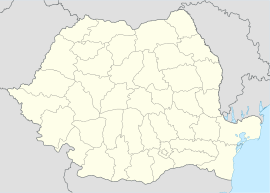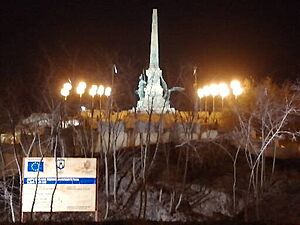Tulcea facts for kids
Quick facts for kids
Tulcea
|
||
|---|---|---|
|
Port of Tulcea
Monument of independence
Tulcea at the end of the 19th century
Former headquarters of the State Fisheries Administration
|
||
|
||
| Country | ||
| County | Tulcea | |
| Area | 177.24 km2 (68.43 sq mi) | |
| Elevation | 30 m (100 ft) | |
| Population
(2011)
|
Lua error in Module:Wd at line 1,575: attempt to index field 'wikibase' (a nil value). | |
| Time zone | EET/EEST (UTC+2/+3) | |
| Postal code |
820002–820249
|
|
| Area code | (+40) 02 40 | |
Tulcea is a city in Northern Dobruja, Romania. It is the main city and administrative center of Tulcea County. As of 2021, about 65,624 people live there. One small village, Tudor Vladimirescu, is also part of the city's administration. Tulcea is special because it is one of only six county capitals in Romania located right on the Danube river.
Contents
What's in a Name?
The city of Tulcea has different names in other languages.
- In Bulgarian, Russian, and Ukrainian, it's called Tulcha.
- In Greek, it's known as Aigissós.
- In Hungarian, it's Tulcsa.
- In Turkish, it's called Tulça.
A Look Back: Tulcea's History
Ancient Times
Tulcea was first built around 700 BC. Back then, it was called Aegyssus. Ancient writers like Procopius mentioned it. Some stories say its name came from a mythical founder named Aegisos.
Aegyssus was built on a tall hill. This spot was perfect for watching over the Danube river, especially when the Romans were in charge. Old clay jars found here show that it was a busy trading place from the 1st century BC to the 1st century AD.
After some attacks by the Getic people around 12-15 AD, the Romans took over the town. They quickly built a new city. After Trajan's Dacian Wars in the early 2nd century AD, Aegyssus became a military fort and port. It was part of the Moesian Limes, which was a defensive border system. A Roman navy unit, the Classis Flavia Moesica, was stationed here.
Public baths were built in the late 1st century AD. They were used for many years, even after being rebuilt several times. In the 3rd century AD, a Roman army unit from Britain, the cohors II Flavia Brittonum, was based here. Later, another unit, the vexillatio Aegyssensis, was also stationed in Aegyssus. The city remained a military base during the 4th and 5th centuries. It was destroyed during attacks by the Huns in the 5th century. However, it was rebuilt by Emperor Justinian I as part of a big project to fix the Danube defenses.
Middle Ages
The town was left empty in the early 7th century. This happened after attacks by the Avars and Slavs, and when the Danube border defenses fell apart. Tulcea is mentioned in old church records as a bishopric in Dobrudja.
People started living there again in the late 10th century. The Byzantines built a fort on the site after they took back the area. This fort was destroyed in 1064 by the Uzes, but some people still lived there. More evidence of a larger settlement appears from the 14th century. The Ottoman Empire took control around 1420. Their rule lasted for about 400 years.
Recent History
Tulcea was first written about with its modern name in 1506. Ottoman customs records described it as an "important center for trade."
Around 1848, it was a small city with a shipyard. It officially became a city in 1860 and a provincial capital. In 1853, The Times newspaper in London noted that "Toultcha" was the last fortified place held by the Turks on the Danube.
During the Russo-Turkish War of 1877–1878, Northern Dobruja and Tulcea saw many conflicts. After the war ended in 1878, Tulcea became part of Romania. This was decided at the Congress of Berlin.
During World War I, Tulcea was occupied by the Central Powers from 1916 to 1918. The statue of Mircea the Elder was removed by Bulgarian troops during this time. Mircea the Elder was a ruler who had brought Dobruja into Wallachia.
Weather in Tulcea
Tulcea has a climate that is a mix of continental and temperate weather. This means it has cold winters and hot summers. Temperatures often drop below freezing (0°C or 32°F) for about 80 days a year. There are also about 17 days a year when the highest temperature is below freezing. Snow usually covers the ground for about 28 days each year.
| Climate data for Tulcea (1991–2020) | |||||||||||||
|---|---|---|---|---|---|---|---|---|---|---|---|---|---|
| Month | Jan | Feb | Mar | Apr | May | Jun | Jul | Aug | Sep | Oct | Nov | Dec | Year |
| Record high °C (°F) | 18.8 (65.8) |
23.5 (74.3) |
28.6 (83.5) |
31.1 (88.0) |
36.1 (97.0) |
36.3 (97.3) |
39.9 (103.8) |
39.8 (103.6) |
34.7 (94.5) |
32.0 (89.6) |
25.7 (78.3) |
19.4 (66.9) |
39.9 (103.8) |
| Mean daily maximum °C (°F) | 3.9 (39.0) |
6.2 (43.2) |
11.1 (52.0) |
17.2 (63.0) |
23.2 (73.8) |
27.5 (81.5) |
29.7 (85.5) |
29.6 (85.3) |
24.1 (75.4) |
17.8 (64.0) |
11.2 (52.2) |
5.5 (41.9) |
17.2 (63.0) |
| Daily mean °C (°F) | 0.0 (32.0) |
1.6 (34.9) |
5.8 (42.4) |
11.4 (52.5) |
17.3 (63.1) |
21.7 (71.1) |
23.7 (74.7) |
23.1 (73.6) |
17.7 (63.9) |
12.0 (53.6) |
6.7 (44.1) |
1.7 (35.1) |
11.9 (53.4) |
| Mean daily minimum °C (°F) | −3.3 (26.1) |
−2.0 (28.4) |
1.6 (34.9) |
6.3 (43.3) |
11.6 (52.9) |
15.7 (60.3) |
17.6 (63.7) |
16.9 (62.4) |
12.2 (54.0) |
7.4 (45.3) |
3.1 (37.6) |
−1.6 (29.1) |
7.1 (44.8) |
| Record low °C (°F) | −18.9 (−2.0) |
−15.9 (3.4) |
−5.0 (23.0) |
0.8 (33.4) |
4.6 (40.3) |
9.6 (49.3) |
8.1 (46.6) |
0.6 (33.1) |
−7.6 (18.3) |
−13.4 (7.9) |
−20.7 (−5.3) |
−20.9 (−5.6) |
−20.9 (−5.6) |
| Average precipitation mm (inches) | 35.3 (1.39) |
26.6 (1.05) |
33.3 (1.31) |
36.4 (1.43) |
43.7 (1.72) |
57.2 (2.25) |
58.0 (2.28) |
31.5 (1.24) |
44.8 (1.76) |
44.3 (1.74) |
41.2 (1.62) |
41.9 (1.65) |
494.2 (19.46) |
| Average precipitation days (≥ 1.0 mm) | 4.9 | 5.0 | 5.4 | 5.9 | 6.3 | 6.0 | 5.4 | 3.6 | 4.3 | 4.5 | 4.7 | 6.1 | 62.1 |
| Mean monthly sunshine hours | 80.9 | 111.5 | 159.2 | 212.3 | 280.4 | 306.7 | 339.7 | 314.3 | 232.0 | 163.9 | 92.8 | 77.1 | 2,370.8 |
| Source: NOAA | |||||||||||||
People of Tulcea
Tulcea is home to many different groups of people. Most residents are Romanians. There are also smaller groups like Lipovans, Roma, Turks, Ukrainians, and Greeks.
Here's a look at the population over time:
| Historical population | ||
|---|---|---|
| Year | Pop. | ±% |
| 1912 | 21,727 | — |
| 1930 | 20,403 | −6.1% |
| 1948 | 21,642 | +6.1% |
| 1956 | 24,639 | +13.8% |
| 1966 | 35,561 | +44.3% |
| 1977 | 61,729 | +73.6% |
| 1992 | 97,904 | +58.6% |
| 2002 | 92,762 | −5.3% |
| 2011 | 73,707 | −20.5% |
| 2021 | 65,624 | −11.0% |
| Source: Census data | ||
| Ethnicity | 2011 | 2021 |
|---|---|---|
| Total | 73,707 | 65,624 |
| Romanian | 61,451 (83.37%) | 49,108 (74.83%) |
| Lipovan | 1,738 (2.36%) | 1,244 (1.9%) |
| Roma | 953 (1.29%) | 1,031 (1.57%) |
| Turkish | 819 (1.11%) | 438 (0.67%) |
| Ukrainian | 376 (0.51%) | 278 (0.42%) |
| Greek | 208 (0.28%) | 178 (0.27%) |
| Bulgarian | 15 (0.02%) | 17 (0.03%) |
| Others | 385 (0.53%) | 251 (0.38%) |
| Unknown | 7762 (10.53%) | 13,079 (19.93%) |
Culture and Landmarks
Tulcea hosts the "George Georgescu Contest." This is a music competition that started in 1992. It's named after George Georgescu, a famous Romanian conductor. The contest was first for Romanian music students. Since 1995, students from other countries can also join.
The Monument of Independence is a major attraction in Tulcea. It stands on the same hill as the old Aegyssus ruins and the history museum. From here, you can get amazing views of the city. The monument is an obelisk with an eagle statue on one side and a soldier statue on the other. It was built to remember the Romanian War of Independence. This war led to Dobruja becoming part of Romania. Construction started on October 17, 1879.
The main high school in the city is the Spiru Haret Dobrujan College.
Famous People from Tulcea
Many notable people have connections to Tulcea:
- Crin Antonescu (born 1959), a former acting President of Romania.
- Georges Boulanger (1893–1958), a talented violinist.
- Alexandru Ciucurencu (1903–1977), a well-known painter.
- Stefan Karadzha (1840–1868), a Bulgarian revolutionary who studied in Tulcea.
- Grigore Moisil (1906–1973), a famous mathematician.
- Dimitar Petkov (1858–1907), who became a Bulgarian Prime Minister.
- Mirela Roznoveanu (born 1947), a literary critic, writer, and journalist.
- Valentin Serbu (1934–1994), a writer.
- Tora Vasilescu (born 1951), a popular actress.
Sister Cities
Tulcea has "sister city" relationships with several cities around the world. These partnerships help promote cultural exchange and friendship.
See also
 In Spanish: Tulcea para niños
In Spanish: Tulcea para niños












